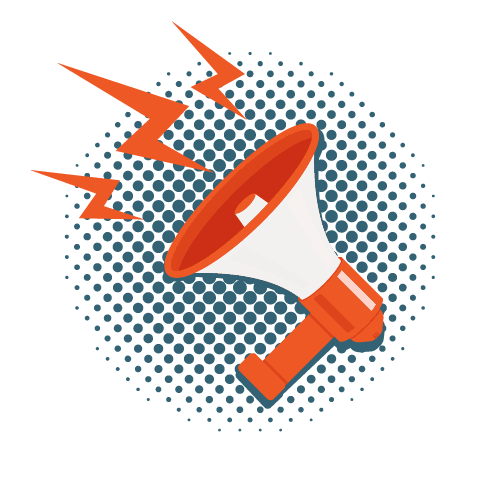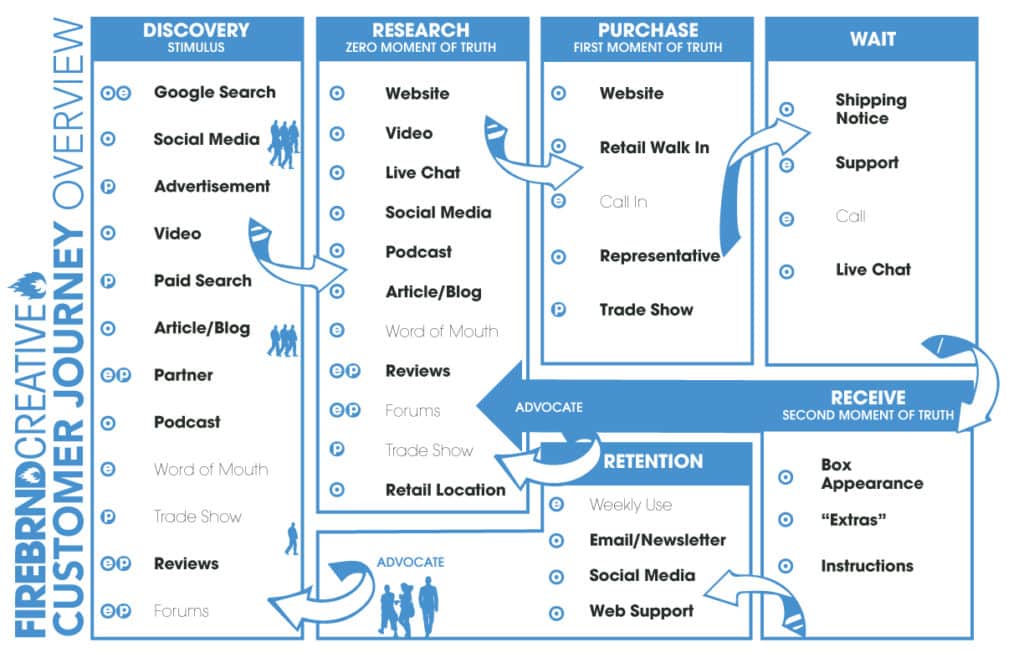For the most part, there are a few aspects of the customer journey, funnel, hourglass, (insert other model here) that will be the same from brand to brand. You may call the stages by different names (which we encourage), so each has a specific meaning to you and your team. Here are 6 of the general stages you will find in almost every model and some of the names they might be called.
- Awareness (discovery, engagement, stimulus)
- Research (consideration, education, evaluation, ZMOT)
- Purchase (conversion, first moment of truth, activation)
- Adoption (second moment of truth)
- Retention (brand marriage, repeat customer)
- Advocate (evangelist, enthusiast)
- Recommended next post
- Other posts you might enjoy
It is not easy to define a Customer Journey that works for every customer. A marketing funnel is impersonal and doesn’t account for the fact that customers in the funnel are not always moving in a downwards direction. The customer journey has drawbacks too. What we like though, is that the language around the Customer Journey lends itself to thinking of people and not processes.
Let’s dive into each of the 6 stages of the Journey to see what they mean and why you need them in your marketing model.
How do customers become aware of your brand? What is the stimulus that captures their attention?
Awareness (discovery, engagement, stimulus)
The process starts when a potential customer becomes aware of your brand. How they become aware of your brand is for another post. There will always be more people aware of your brand than are purchasing products from you.
This is where the Journey begins. Older marketing models called this the stimulus. In today’s age, I think awareness or discovery is a better term. Awareness better describes where a customer is in the journey. They are aware of your brand but have not yet done anything proactive towards your brand.
Once a customer is aware of your brand, you have the opportunity to catch their eye and offer them more information as they are doing their Research.
What information do you provide so that a customer can make a decision that leads to purchasing your product?
Research (consideration, education, evaluation, ZMOT)

When the customer knows about you and has a need for your product or service, they take the next step on the journey and start to research your company. This is often called the consideration stage of a funnel. Your brand is generally not the only brand they are researching so providing the right content at the right time is critical to move them to conversion or purchase.
Quite a lot has been written on this stage as it has become the “way we do things.” Google has some great resources on this, they call it the Zero Moment of Truth.
In short, people today do some form of research before making a purchase. It may be 1 month or 1 minute before, but at some point, something gets Googled. And it doesn’t matter how small. From cars to toilet paper, we want to know which is best. When a customer goes to look into something, are they finding your brand? That is the essence of the ZMOT.
Think about your own purchase habits. When you have a need, you search it on Google. Then you may look at reviews, maybe a video, and then you make the purchase. For example, the other day a friend posted about his experience with Apple Cider vinegar gummies (he was an Advocate, see below) that don’t taste like vinegar. After seeing his post (awareness), I had some heartburn. I Googled how to treat acid reflux and apple cider vinegar came up. Oh, I wonder if those Goli gummies would work, I thought. Finally, I looked up reviews, saw that they might work, and made the Purchase.
How easy is it for customers to purchase your product after they have done the research and decided you are the right brand for them?
Purchase (conversion, first moment of truth, activation)

There is not much to describe here. Customers who do their research and decide your product is right for them will make a purchase. This is often called CONVERSION. With the sheer number of options they have, this is a big win and should be celebrated as such.
Proctor & Gamble coined the phrase First Moment of Truth back in ancient times when we used to look at a store shelf to compare products. It was said that a brand only had 7 seconds to make an impact on a store shelf.
Purchase is where the customer makes a decision based on all the facts (and feelings) they have at the time.
Some models stop here. The dollars have been counted and you have successfully converted a window shopper to a purchaser. But stopping here will fail to leverage some of the most powerful parts of the journey. A satisfied customer who recommends you to others (organically, not a paid influencer) becomes a part of someone else’s customer journey. This is where exponential growth can occur.
Your customer has your product in hand. What do they feel about it? Do they feel they made a good choice?
Adoption (second moment of truth)
After the customer receives the product or service they purchased, what happens? What do they feel when they open the box for the first time? How is their experience with a support team if the product is not what they expected? Is the product easy to use or setup?
Apple has mastered the “post-purchase wow”. Each part of the box opening to product setup is designed to reinforce that you made a good purchase decision. From the shrink wrap to the apple sticker, every layer adds to the sense that you are holding something precious.
The overall question here is “Did this brand, product, or service live up to the promise?” This is the “Second Moment of Truth,” where the customer decides if the purchase was a good one. If it was….
This is a brand I can get behind. The service was great, the product does what it says it would do, yeah… I like this.
Retention (brand marriage, repeat customer)
Retention is about ongoing use and enjoyment. There are some products that I love to own, even if I don’t use them that often. When I pick it up I think… Oh, I am so glad I have this. There are other products that started to live up to the promise on day one but after three months stopped working.
Will I buy this again? Do I need to add to my purchase? Should I change brands next time? All these questions are answered here.
Having this stop on the Customer Journey built into your plan is critical because the user can do a few things here.
- Continue to use your brand
- Stop using your brand
- Tell others about a bad experience
- Tell others about a good experience.
Managing the customer experience doesn’t stop at the purchase. Keeping this in mind will inform your warranty policy, customer service policies and practice, email follow up, and even quality control. This is where the voice of the customer is often the loudest.
A customer that continues to delight in the purchase over time is more likely to tell others about it and become an…
Friends, you REALLY need to try this out. I didn’t think that I could like a product this much!
Advocate (evangelist, enthusiast)

This is the motherlode. The holy grail. A customer who has gone from being aware to being an advocate. An advocate tells others about the brand. They bring awareness to new potential customers. And their weight is worth a lot. An unpaid advocate can tell others WHY they love your brand. They are now walking the Customer Journey with other customers.
Back to my apple cider vinegar story, my friend posted about his experience and I ultimately purchased the product. It was a short journey for me. The advocacy of a happy customer brought in other customers. That is the goal of the Customer Journey!
Adding to the 6 core steps to map the journey for your own customers
These are just the main stops along the customer journey. You might (and should) get a bit more granular or add other steps. For example, we have a client who makes in-ear monitors for live musicians. After the customer makes the purchase, they have to get impressions made of their ears and send them to us. Then they have to wait while the earphone is being custom made, just for them. So there are a few steps between PURCHASE and ADOPTION that are important. And what happens in those steps influences adoption and retention.
What are the unique steps a customer takes for your product? Start with the above framework and add “vistas” on the journey specific to your brand. In the image below, we have a fairly standard Customer Journey depiction. The icons to the left state whether the effort is Paid, Earned or Owned (more on that on our Jumpstart Your Marketing in 5 Easy(ish) Steps post), and the bold means it can be directly controlled by the efforts of the team. The marketing efforts generally go from top to bottom, influencing most people at the top and fewest at the bottom.

This is a handy reference tool as you can see what you can impact, what you can’t, what costs money, and what costs time. You can see what you can be working on and what might be the first to go when budgets get tight. But please, do not let this be static. It will change and fluctuate as your brand grows, just like any actual journey.
Once you have a general framework, it’s time to look at who the customer is and where they spend their time. This will help you build a specific plan to reach them where they are.
Recommended next post
Jumpstart Your Marketing in 5 Easy(ish) Steps
